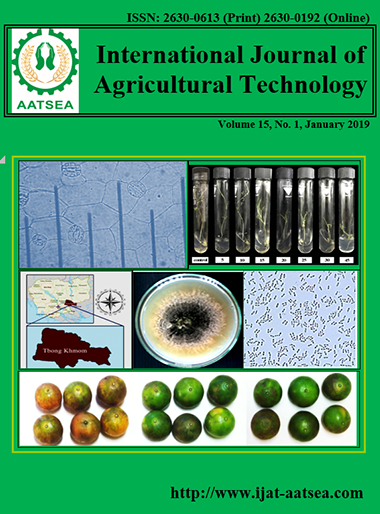Toxicity property of clove oil (Syzygium aromaticum L.) and rice grain protection against Rhyzopertha dominica (Fabricius) and Sitophilus zeamais Motschulsky
Main Article Content
Abstract
Rhyzopertha dominica and Sitophilus zeamais caused considerable damage on rice stored grains. These stored insects are normally controlled during storage mainly by synthetic insecticides for grain protection and fumigation. Plant extract was highly conducted with effectiveness against stored grain insects and can be an alternative application which is safety to natural environment and consumers. This study investigated the application of clove oil (Syzygium aromaticum L.) by grain treatment as well as effects to their insecticide activity, inhibition progeny production, and grain damage (weight loss) as compared with chlorpyrifos under laboratory. The results showed that clove oil coating at 200 µL/L after 7 days of application had performed the mortality percentage of R. dominica and S. zeamais at 99.33% and 95.33%, whereas chlorpyrifos was showed mortality percentage at 66.00% and 100%, respectively. The study indicated that this insecticide was lower effective to kill R. dominica than clove oil, but all of them were still effective to kill S. zeamais. For F1 inhibition emergence, the clove oil inhibited adult emergence both R. dominica and S. zeamais, whereas chlorpyrifos was highly inhibited to the emerged adults of R. dominica than S. zeamais adults. Weight loss and frass production of grain coated with clove oil showed the greater in S. zeamais than that in R. dominica. This attributed to more susceptible of R. dominica to clove oil than S. zeamais. Hence, grain coating with clove oil is an alternative method for promising as seed protectants from R. dominica and S. zeamais in warehouse in the future. Clove oil is safety, environmental-friendly, and reduces the use of synthetic insecticide. However, this method should be further studied in terms of reasonable application such as economic-value consideration.
Article Details

This work is licensed under a Creative Commons Attribution-NonCommercial-NoDerivatives 4.0 International License.
References
Abbott, W. S. (1925). A method of computing the effectiveness of an Insecticide. Journal of Economic Entomology. 18:265-267.
Ahman, F., Sagheer, M., Hammad, A., Rahman, S.M. and UL-Hasan, M. (2013). Insecticide activity of some plant extracts against Trogoderma granarium E. A scientific journal of Krishi Foundation. 11:103-111.
Finney, D. J. (1971). Probit analysis, 3rd Edition. London, UK: Cambridge University Press, pp.333.
Groor, I. (2004). Protection of stored grains and pulses. Agromisa Foundation, Wageningen, pp.78.
Hasan, M. M. and Reichmuth, C. (2004). Relative toxicity of phosphine against the bean bruchid Acanthoscelides obtectus (Say) (Col., Bruchidae). Journal of Applied Entomology. 128:332-336.
Hayashi, T., Nakamura, S., Visarathanonth, P., Uraichuen, J. and Kengkanpanich, R. (2004). Stored rice insect pests and their natural enemies in Thailand. JIRCAS International Agricultural Series. pp. 79.
Ho, S. H., Cheng, L. P. L., Sim, K. Y. and Tan, H. T. W. (1994). Potential of cloves (Syzygium aromaticum (L.) Merr and Perry) as a grain protectant against Tribolium castaneum (Herbst) and Sitophilus zeamais Motsch. Postharvest Biology and Technology. 4:179-183.
Ho, S. H., Ma, Y. and Huang, Y. (1997). Anethol, a potential insecticide from Allicium verum Hook F., against two stored product insects. International pest control Allicium verum Hook f. as a potential grain protectant against Tribolium castaneum (Herbst) and Sitophilus zemais Mostch. Postharvest Biology and Technology. 6:341-347.
Houghton, P. J., Ren, Y. and Howes, M. J. (2006). Acetylcholinesterase inhibitors from plants and fungi. Natural Product Reports. 23:181-199.
Michaelraj, S. and Sharma, R. K. (2006). Fumigant toxicity of neem formulations against Sitophilus oryzae and Rhyzopertha dominica. Journal of Agricultural Technology. 2:1-16.
Mohan, S. and Fields, P. G. (2002). A simple technique to assess compounds that are repellents or attractive to stored-products insects. Journal of Stored Products Research. 33:289-298.
Naima, K., Anouar, K. M. and Nassima, B. (2013). Evaluation of the insecticidal activity of the aerial part of Pseudocytisus integrifolius (Salisb) Rehder on grain borer, Rhyzopertha dominica Fab. (Bostrychidae) and wheat weevil, Sitophilus granarius Linn. (Curculionidae). Journal of Life Science. 7:700-704.
Paranhos, B. A. J., Custódio, C. C., Machado N. N. B. and Rodrigues, A. S. (2006). Extrato de neem e cravo-da-índia no controle de Zabrotes subfasciatus (Boheman) (Coleoptera: Bruchidae) em sementes de feijão armazenado. Colloquium Agrariae. 1:1-7.
Patel, K., Valand, V. and Patel, S. (1993). Powder of neem-seed kernel for control of lesser grain borer (Rhyzopertha dominica) in wheat (Triticum aestivum) Indian. Journal of Agricultural Science. 63:754-755.
Rajendran, S. and Sriranjini, V. (2008). Plant products as fumigants for stored product insect control. Journal of Stored Products Research. 44:126-135.
Samson, P. R. and Parker, R. J. (1990). Synergised deltamethrin as a protectant against Sitophilus zeamais Motsch. and Sitophilus oryzae (L.) (Coleoptera: Curculionidae) on stored maize. Journal of Stored Products Research. 26:155-161.
Sharma, K. and Meshram, N. M. (2006). Bioactive of essential oils from Acorus calamus Linnaeus and Syzygium aromaticum Linnaeus against Sitophilus oryzae (Linnaeus) in stored wheat. Biopesticides International. 2:144-152.
Singh, A., Khare, A. and Singh, A. P. (2012). Use of vegetable oils as biopesticide in grain protection -a review. Journal of Agricultural Science and Food Research. 3:1-9.
Tapondjou, L., Adler, C., Bouda, H. and Fontem, D. (2002). Efficacy of powder and essential oil from Chenopodium ambrosioides leaves as post-harvest grain protectants against six-stored product beetles. Journal of Stored Products Research. 38:395-402.
Zeng, L. (1999). Development and counter measures of phosphine resistance in stored grain insects in Guandong of China. In: Stored product protection, Proceedings of 7th Inenational working Conference on stored-product protection, Beijing, China, pp. 642-647.


